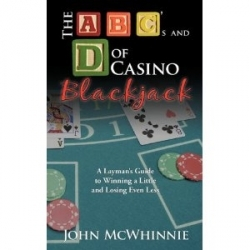The A, B, C’s, and D of Casino Blackjack
A Layman’s Guide to Winning a Little and Losing Even Less
“You should never, ever increase your bets to chase losses.” While this may seem like common sense for any game where chance is involved, author John McWhinnie has seen countless blackjack players fall into this trap. A key principle of McWhinnie’s strategy is to be consistent and not let the natural winning and losing streaks alter your behavior.
McWhinnie obtained a bachelor’s degree in honors mathematics, as well as a master’s degree in applied statistics. In addition to his mathematics background, he has been an avid blackjack player for more than forty years.
McWhinnie presents his knowledge of blackjack in practical terms and in an easy-to-understand language. However, some readers may find the strategy and card-counting scenarios a bit confusing. The author covers all facets of casino blackjack, including how to choose a table, playing etiquette, and the atmosphere to expect. All the information will be especially helpful for players who are unfamiliar with the particulars of casino blackjack.
One interesting tactic McWhinnie employs is taking the player along on a virtual game of blackjack at a casino. Here the player encounters all kinds of interesting and sometimes annoying types of people. In this scene, we’ll see how McWhinnie highlights an example of using basic strategy, even though it doesn’t guarantee a win: “We can overhear Louise …whisper, ‘That guy really screwed up,’ but [we] remember we did exactly the right thing. It just doesn’t always work out. Had we sat on 14, instead of splitting … [the dealer]would have gotten that third 7 and made 19, still beating the table.”
By playing out hypothetical scenarios the player learns what can happen when one follows McWhinnie’s recommended strategy and what happens when one doesn’t follow it. By grasping why the strategy works in the long run, it becomes clear why certain decisions make sense, even if at first glimpse they appear to cause a player to lose money.
In one such scenario, betting higher to make up for lost hands is not a good idea. McWhinnie explains how quickly a player’s losses can get out of control when the cards aren’t in their favor: “The folly in this process is how quickly your bets must jump if you lose several hands. Let’s assume you lose four hands in a row on a $15 bet. Your second bet would be $30, your third would be $60 and your fourth …$120. Now you are looking at risking $240 to win back your original $15.”
Card enthusiasts interested in improving their blackjack skills will find this book entertaining. Readers who enjoy entertaining nonfiction books might also find this book interesting.
By applying logic, statistics, and consistency to casino blackjack, McWhinnie provides a realistic guide to doing just what the book’s subtitle states: winning a little and losing even less.
Reviewed by
Laura Munion
Disclosure: This article is not an endorsement, but a review. The publisher of this book provided free copies of the book and paid a small fee to have their book reviewed by a professional reviewer. Foreword Reviews and Clarion Reviews make no guarantee that the publisher will receive a positive review. Foreword Magazine, Inc. is disclosing this in accordance with the Federal Trade Commission’s 16 CFR, Part 255.

